Weihong Lin
Evaluation is All You Need: Strategic Overclaiming of LLM Reasoning Capabilities Through Evaluation Design
Jun 05, 2025Abstract:Reasoning models represented by the Deepseek-R1-Distill series have been widely adopted by the open-source community due to their strong performance in mathematics, science, programming, and other domains. However, our study reveals that their benchmark evaluation results are subject to significant fluctuations caused by various factors. Subtle differences in evaluation conditions can lead to substantial variations in results. Similar phenomena are observed in other open-source inference models fine-tuned based on the Deepseek-R1-Distill series, as well as in the QwQ-32B model, making their claimed performance improvements difficult to reproduce reliably. Therefore, we advocate for the establishment of a more rigorous paradigm for model performance evaluation and present our empirical assessments of the Deepseek-R1-Distill series models.
Mavors: Multi-granularity Video Representation for Multimodal Large Language Model
Apr 14, 2025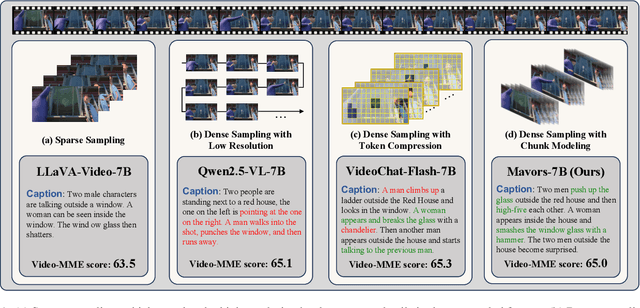

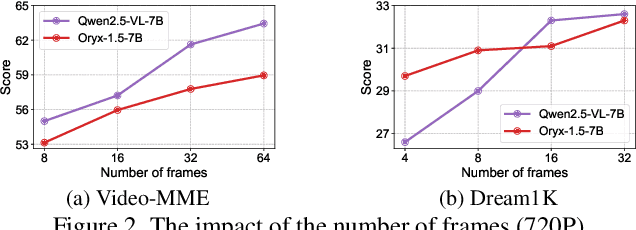
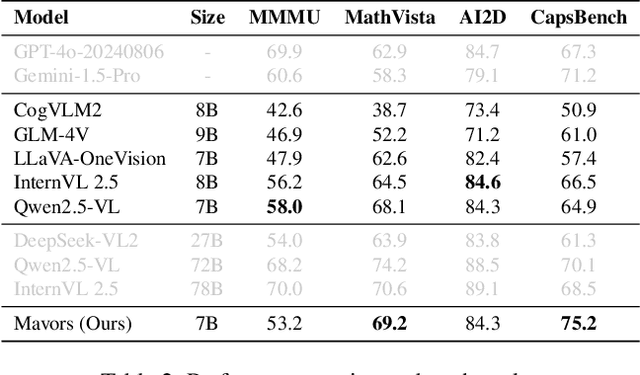
Abstract:Long-context video understanding in multimodal large language models (MLLMs) faces a critical challenge: balancing computational efficiency with the retention of fine-grained spatio-temporal patterns. Existing approaches (e.g., sparse sampling, dense sampling with low resolution, and token compression) suffer from significant information loss in temporal dynamics, spatial details, or subtle interactions, particularly in videos with complex motion or varying resolutions. To address this, we propose $\mathbf{Mavors}$, a novel framework that introduces $\mathbf{M}$ulti-gr$\mathbf{a}$nularity $\mathbf{v}$ide$\mathbf{o}$ $\mathbf{r}$epre$\mathbf{s}$entation for holistic long-video modeling. Specifically, Mavors directly encodes raw video content into latent representations through two core components: 1) an Intra-chunk Vision Encoder (IVE) that preserves high-resolution spatial features via 3D convolutions and Vision Transformers, and 2) an Inter-chunk Feature Aggregator (IFA) that establishes temporal coherence across chunks using transformer-based dependency modeling with chunk-level rotary position encodings. Moreover, the framework unifies image and video understanding by treating images as single-frame videos via sub-image decomposition. Experiments across diverse benchmarks demonstrate Mavors' superiority in maintaining both spatial fidelity and temporal continuity, significantly outperforming existing methods in tasks requiring fine-grained spatio-temporal reasoning.
TinyR1-32B-Preview: Boosting Accuracy with Branch-Merge Distillation
Mar 06, 2025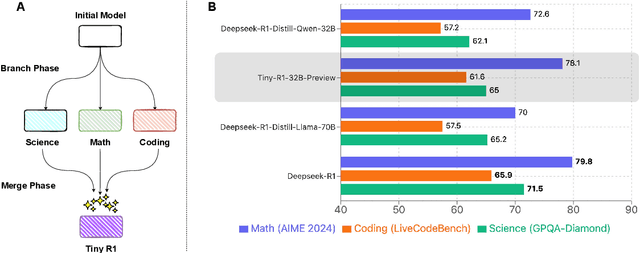

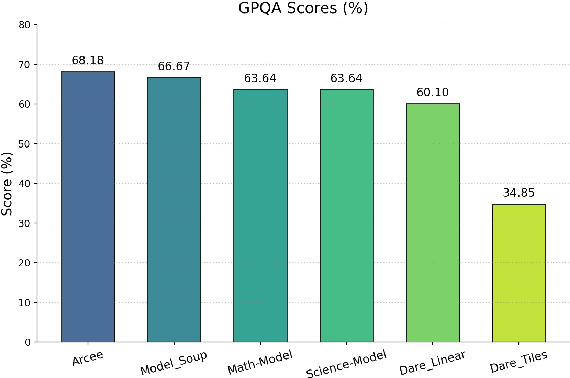

Abstract:The challenge of reducing the size of Large Language Models (LLMs) while maintaining their performance has gained significant attention. However, existing methods, such as model distillation and transfer learning, often fail to achieve high accuracy. To address this limitation, we introduce the Branch-Merge distillation approach, which enhances model compression through two phases: (1) the Branch Phase, where knowledge from a large teacher model is \textit{selectively distilled} into specialized student models via domain-specific supervised fine-tuning (SFT); And (2) the Merge Phase, where these student models are merged to enable cross-domain knowledge transfer and improve generalization. We validate our distillation approach using DeepSeek-R1 as the teacher and DeepSeek-R1-Distill-Qwen-32B as the student. The resulting merged model, TinyR1-32B-Preview, outperforms its counterpart DeepSeek-R1-Distill-Qwen-32B across multiple benchmarks, including Mathematics (+5.5 points), Coding (+4.4 points) and Science (+2.9 points), while achieving near-equal performance to DeepSeek-R1 on AIME 2024. The Branch-Merge distillation approach provides a scalable solution for creating smaller, high-performing LLMs with reduced computational cost and time.
HAIC: Improving Human Action Understanding and Generation with Better Captions for Multi-modal Large Language Models
Feb 28, 2025Abstract:Recent Multi-modal Large Language Models (MLLMs) have made great progress in video understanding. However, their performance on videos involving human actions is still limited by the lack of high-quality data. To address this, we introduce a two-stage data annotation pipeline. First, we design strategies to accumulate videos featuring clear human actions from the Internet. Second, videos are annotated in a standardized caption format that uses human attributes to distinguish individuals and chronologically details their actions and interactions. Through this pipeline, we curate two datasets, namely HAICTrain and HAICBench. \textbf{HAICTrain} comprises 126K video-caption pairs generated by Gemini-Pro and verified for training purposes. Meanwhile, \textbf{HAICBench} includes 500 manually annotated video-caption pairs and 1,400 QA pairs, for a comprehensive evaluation of human action understanding. Experimental results demonstrate that training with HAICTrain not only significantly enhances human understanding abilities across 4 benchmarks, but can also improve text-to-video generation results. Both the HAICTrain and HAICBench are released at https://huggingface.co/datasets/KuaishouHAIC/HAIC.
UniVIE: A Unified Label Space Approach to Visual Information Extraction from Form-like Documents
Jan 17, 2024Abstract:Existing methods for Visual Information Extraction (VIE) from form-like documents typically fragment the process into separate subtasks, such as key information extraction, key-value pair extraction, and choice group extraction. However, these approaches often overlook the hierarchical structure of form documents, including hierarchical key-value pairs and hierarchical choice groups. To address these limitations, we present a new perspective, reframing VIE as a relation prediction problem and unifying labels of different tasks into a single label space. This unified approach allows for the definition of various relation types and effectively tackles hierarchical relationships in form-like documents. In line with this perspective, we present UniVIE, a unified model that addresses the VIE problem comprehensively. UniVIE functions using a coarse-to-fine strategy. It initially generates tree proposals through a tree proposal network, which are subsequently refined into hierarchical trees by a relation decoder module. To enhance the relation prediction capabilities of UniVIE, we incorporate two novel tree constraints into the relation decoder: a tree attention mask and a tree level embedding. Extensive experimental evaluations on both our in-house dataset HierForms and a publicly available dataset SIBR, substantiate that our method achieves state-of-the-art results, underscoring the effectiveness and potential of our unified approach in advancing the field of VIE.
A Question-Answering Approach to Key Value Pair Extraction from Form-like Document Images
Apr 17, 2023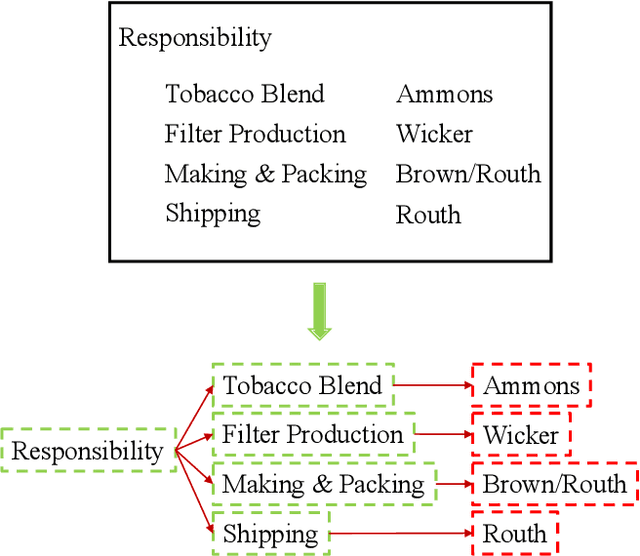
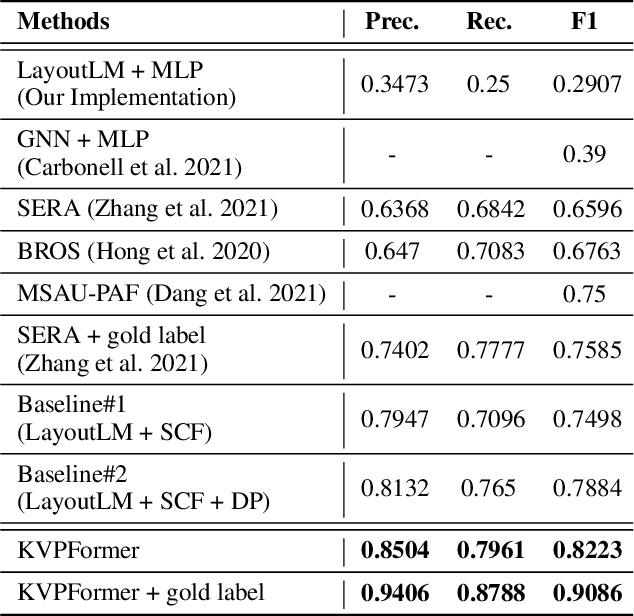
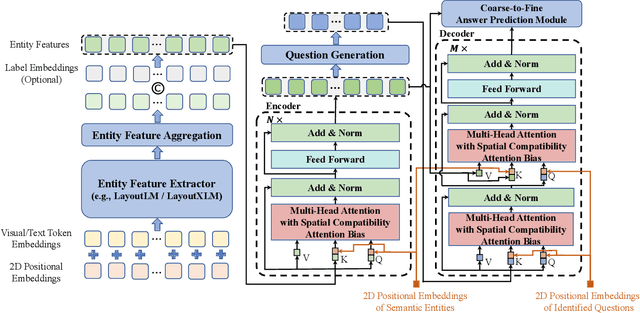

Abstract:In this paper, we present a new question-answering (QA) based key-value pair extraction approach, called KVPFormer, to robustly extracting key-value relationships between entities from form-like document images. Specifically, KVPFormer first identifies key entities from all entities in an image with a Transformer encoder, then takes these key entities as \textbf{questions} and feeds them into a Transformer decoder to predict their corresponding \textbf{answers} (i.e., value entities) in parallel. To achieve higher answer prediction accuracy, we propose a coarse-to-fine answer prediction approach further, which first extracts multiple answer candidates for each identified question in the coarse stage and then selects the most likely one among these candidates in the fine stage. In this way, the learning difficulty of answer prediction can be effectively reduced so that the prediction accuracy can be improved. Moreover, we introduce a spatial compatibility attention bias into the self-attention/cross-attention mechanism for \Ours{} to better model the spatial interactions between entities. With these new techniques, our proposed \Ours{} achieves state-of-the-art results on FUNSD and XFUND datasets, outperforming the previous best-performing method by 7.2\% and 13.2\% in F1 score, respectively.
Robust Table Structure Recognition with Dynamic Queries Enhanced Detection Transformer
Mar 21, 2023Abstract:We present a new table structure recognition (TSR) approach, called TSRFormer, to robustly recognizing the structures of complex tables with geometrical distortions from various table images. Unlike previous methods, we formulate table separation line prediction as a line regression problem instead of an image segmentation problem and propose a new two-stage dynamic queries enhanced DETR based separation line regression approach, named DQ-DETR, to predict separation lines from table images directly. Compared to Vallina DETR, we propose three improvements in DQ-DETR to make the two-stage DETR framework work efficiently and effectively for the separation line prediction task: 1) A new query design, named Dynamic Query, to decouple single line query into separable point queries which could intuitively improve the localization accuracy for regression tasks; 2) A dynamic queries based progressive line regression approach to progressively regressing points on the line which further enhances localization accuracy for distorted tables; 3) A prior-enhanced matching strategy to solve the slow convergence issue of DETR. After separation line prediction, a simple relation network based cell merging module is used to recover spanning cells. With these new techniques, our TSRFormer achieves state-of-the-art performance on several benchmark datasets, including SciTSR, PubTabNet, WTW and FinTabNet. Furthermore, we have validated the robustness and high localization accuracy of our approach to tables with complex structures, borderless cells, large blank spaces, empty or spanning cells as well as distorted or even curved shapes on a more challenging real-world in-house dataset.
Expediting Large-Scale Vision Transformer for Dense Prediction without Fine-tuning
Oct 03, 2022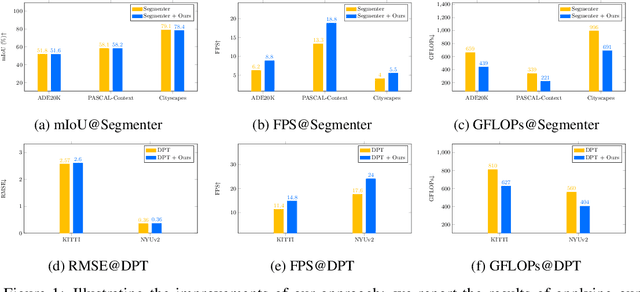

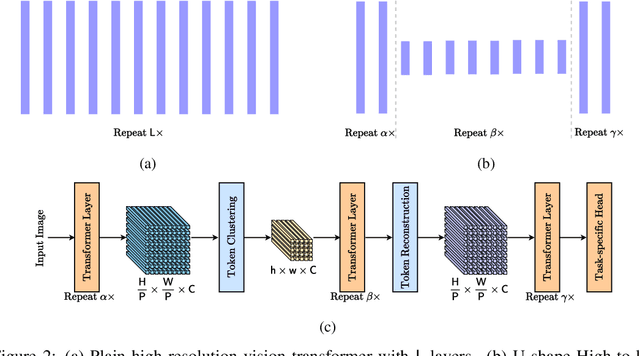

Abstract:Vision transformers have recently achieved competitive results across various vision tasks but still suffer from heavy computation costs when processing a large number of tokens. Many advanced approaches have been developed to reduce the total number of tokens in large-scale vision transformers, especially for image classification tasks. Typically, they select a small group of essential tokens according to their relevance with the class token, then fine-tune the weights of the vision transformer. Such fine-tuning is less practical for dense prediction due to the much heavier computation and GPU memory cost than image classification. In this paper, we focus on a more challenging problem, i.e., accelerating large-scale vision transformers for dense prediction without any additional re-training or fine-tuning. In response to the fact that high-resolution representations are necessary for dense prediction, we present two non-parametric operators, a token clustering layer to decrease the number of tokens and a token reconstruction layer to increase the number of tokens. The following steps are performed to achieve this: (i) we use the token clustering layer to cluster the neighboring tokens together, resulting in low-resolution representations that maintain the spatial structures; (ii) we apply the following transformer layers only to these low-resolution representations or clustered tokens; and (iii) we use the token reconstruction layer to re-create the high-resolution representations from the refined low-resolution representations. The results obtained by our method are promising on five dense prediction tasks, including object detection, semantic segmentation, panoptic segmentation, instance segmentation, and depth estimation.
TSRFormer: Table Structure Recognition with Transformers
Aug 09, 2022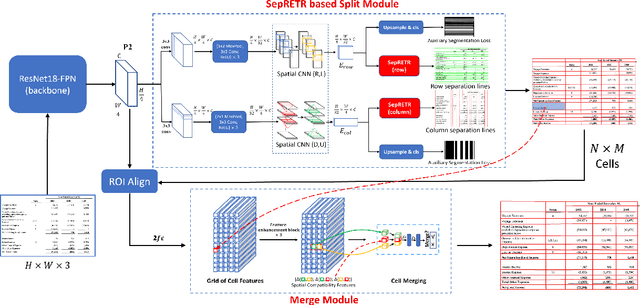
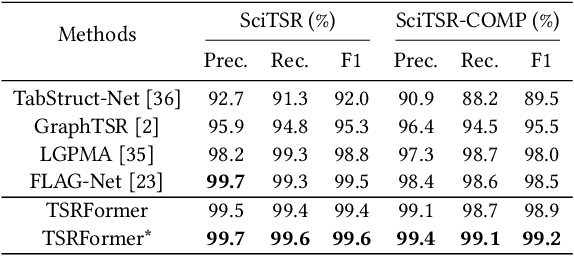
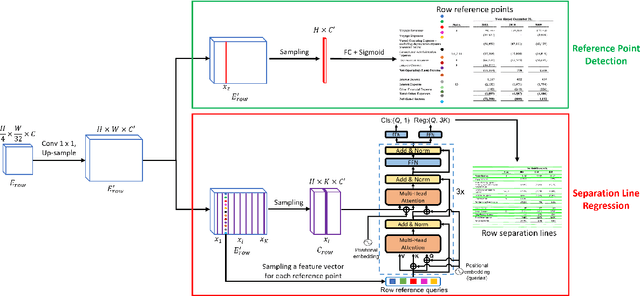

Abstract:We present a new table structure recognition (TSR) approach, called TSRFormer, to robustly recognizing the structures of complex tables with geometrical distortions from various table images. Unlike previous methods, we formulate table separation line prediction as a line regression problem instead of an image segmentation problem and propose a new two-stage DETR based separator prediction approach, dubbed \textbf{Sep}arator \textbf{RE}gression \textbf{TR}ansformer (SepRETR), to predict separation lines from table images directly. To make the two-stage DETR framework work efficiently and effectively for the separation line prediction task, we propose two improvements: 1) A prior-enhanced matching strategy to solve the slow convergence issue of DETR; 2) A new cross attention module to sample features from a high-resolution convolutional feature map directly so that high localization accuracy is achieved with low computational cost. After separation line prediction, a simple relation network based cell merging module is used to recover spanning cells. With these new techniques, our TSRFormer achieves state-of-the-art performance on several benchmark datasets, including SciTSR, PubTabNet and WTW. Furthermore, we have validated the robustness of our approach to tables with complex structures, borderless cells, large blank spaces, empty or spanning cells as well as distorted or even curved shapes on a more challenging real-world in-house dataset.
DETRs with Hybrid Matching
Jul 26, 2022
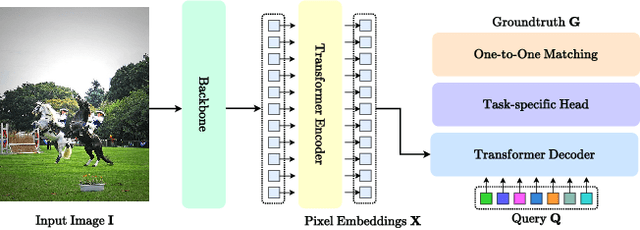


Abstract:One-to-one set matching is a key design for DETR to establish its end-to-end capability, so that object detection does not require a hand-crafted NMS (non-maximum suppression) method to remove duplicate detections. This end-to-end signature is important for the versatility of DETR, and it has been generalized to a wide range of visual problems, including instance/semantic segmentation, human pose estimation, and point cloud/multi-view-images based detection, etc. However, we note that because there are too few queries assigned as positive samples, the one-to-one set matching significantly reduces the training efficiency of positive samples. This paper proposes a simple yet effective method based on a hybrid matching scheme that combines the original one-to-one matching branch with auxiliary queries that use one-to-many matching loss during training. This hybrid strategy has been shown to significantly improve training efficiency and improve accuracy. In inference, only the original one-to-one match branch is used, thus maintaining the end-to-end merit and the same inference efficiency of DETR. The method is named $\mathcal{H}$-DETR, and it shows that a wide range of representative DETR methods can be consistently improved across a wide range of visual tasks, including Deformable-DETR, 3DETR/PETRv2, PETR, and TransTrack, among others. Code will be available at: https://github.com/HDETR
 Add to Chrome
Add to Chrome Add to Firefox
Add to Firefox Add to Edge
Add to Edge